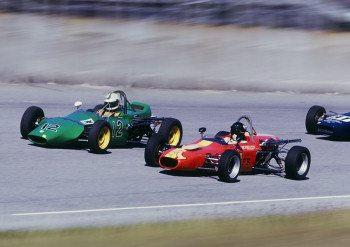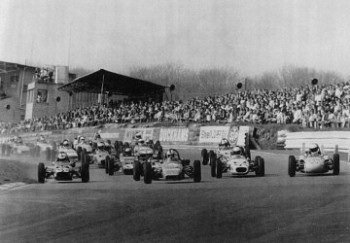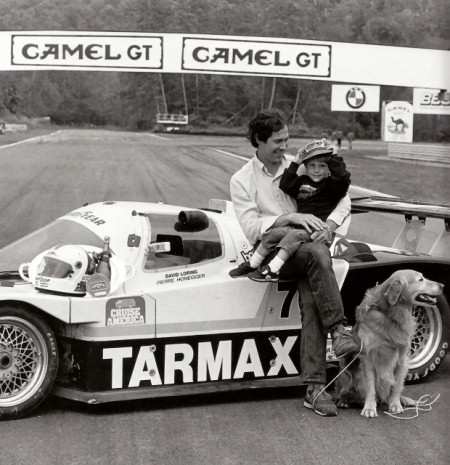The Way It Is/ Appreciating the life of an old friendby Gordon Kirby |
 I intended to write about this year's IndyCar championship this week but the unexpected death last Friday night of my old friend David Loring moved me to write instead about David's eclectic life and career as a race car driver and car builder. Through the seventies David was America's most successful Formula Ford racer winning more than fifty races across the United States, Canada and England, culminating in taking the SCCA's American Formula Ford championship at Road Atlanta in 1978 driving a factory AAR Eagle he built and developed for Dan Gurney.
I intended to write about this year's IndyCar championship this week but the unexpected death last Friday night of my old friend David Loring moved me to write instead about David's eclectic life and career as a race car driver and car builder. Through the seventies David was America's most successful Formula Ford racer winning more than fifty races across the United States, Canada and England, culminating in taking the SCCA's American Formula Ford championship at Road Atlanta in 1978 driving a factory AAR Eagle he built and developed for Dan Gurney.
In the eighties David built, developed and successfully raced the unique Denali-Mazda Camel Light car for Pierre Honegger and they also teamed up to tackle the China Rally. Later, David won a bunch of IMSA races, including four Sebring 12 Hour class wins in Camel Light, GTU and GTO cars. After retiring from driving David worked for a few years as a prized instructor and driver coach for Skip Barber before opening his own race car preparation and restoration shop, David Loring Racing, in Conway, New Hampshire. Married to Kathy, a bright, articulate high school English teacher, he fathered two healthy sons Evan and Alyks and lived for the past 27 years amid New Hampshire's White Mountains in his grandfather's house 'Graycroft' which he had painstakingly restored and refurbished. The house sits quietly amid thirty forested acres with a fine view to the north from the dining room and front porch of Mount Chocorua. 'Graycroft' was his pride and joy. I first met David back in 1969 when he was a pudgy teen-aged Formula Vee racer. We got along well and when he raced a factory-backed Caldwell D9 Formula Ford the following two years I helped David and his little family team go racing. He established his early reputation by winning more than 30 Formula Ford races in 1970 and '71, taking no fewer than four different Formula Ford championships in '71.  © David Hutson Chris and David prepared David's Caldwell D9s in the barn behind the Loring family home on Lowell Road just outside Concord, Mass. Thanks to David's open-minded parents Charlie and Tory the Loring house was also an eclectic place attracting all manner of musicians, artists, canoe trekkers and motorcycle racers. David's twin brother Stephen studied archaeology and has worked for the Smithsonian for many years as an expert in native American people. Their youngest brother Eric followed in Stephen's footsteps, specializing in the Inuit people and spending a good deal of his time working in the Canadian north. Back in 1971 Skip Barber and Ray Caldwell, the founder and boss of Autodynamics, wanted David to race a Formula 5000 car the following year in the SCCA's growing F5000 series. But his mind was set on going to Europe to pursue his dream of making it to Formula One chasing in the wheel tracks of his heroes Jim Clark and Ronnie Peterson. One of the four Formula Ford championships David won in 1971 was an Eastern Canadian Jim Russell series which promised the champion a season in Europe driving a Jim Russell Lotus Formula 3 car. It was a big lure for David and took us both to the UK in the fall of '71 to put together an F3 season for the next year. But the Russell prize turned out to be less than promised and with limited funds David resigned himself to racing in Formula Ford for another season. We settled for the year in a little town called Wivenhoe in rural Essex near Colchester Racing Developments where the successful Merlyn FF and F3 cars were built. David prepared his car at the Merlyn shop and raced in the British FF championship, winning five races and setting a track record at Mallory Park which stood for five years.  Formula Ford in its' heyday, Brands Hatch 1972. David Loring (#55) on the inside, one wheel in the grass Photo courtesy David Loring collection David won some SCCA races for Williams and began to break into the professional Atlantic ranks, scrounging rides with his willingness and ability to work on preparing the cars. In the middle of 1974 Gilles Villeneuve crashed at Mosport and broke a leg and David was selected by Ecurie Canada boss Kris Harrison to replace the injured Gilles for a few races. He did a great job finishing second in one of three races and taking pole in another before Gilles returned at the end of the season. Late in 1976 David got a call from no less than Dan Gurney who told him All American Racers was designing a Formula Ford. Dan said he wanted David to move to Calfornia and go to work at AAR to build, develop and race the car. Even though it was still a mere Formula Ford, it was a rare opportunity. Like all of us, David had immense respect for Dan and loved his two years of hard work with AAR. In 21 races over two years racing the Eagle Formula Ford David won 6 times, took nine other podium finishes and set half a dozen track records. He rounded out his tenure with AAR with a runaway win in the SCCA's 1978 Run-offs at Road Atlanta and always said he learned many, many things from Dan and Phil Remington who David held in particularly high regard as a human being as well as an incomparable master fabricator. "The best man I ever met," David would remark about Remington. Following his spell with AAR David worked for John Paul Sr. for a few years helping John Paul Jr. move up from Formula Fords to Atlantic cars before joining his father in Paul Sr.'s Porsche 935 IMSA cars. David and John Jr. got along well and remained lifelong friends but the same couldn't be said for David's relationship with the volatile Paul Sr.  © Hal Crocker Another eclectic soul with many interests Honneger got seriously into racing in the early eighties, commissioning and racing his own Mazda-powered Camel Light car. Honneger invited David to co-drive with him at Daytona at the end of 1984 and the relationship blossomed as Honneger asked David to build an all-new car. David spent six months in Italy building the car which was named the Denali in memory of his years in Alaska. He also enlisted Eagle designer John Ward and Newman/Haas engineer and VDS Can-Am car designer Tony Cicale to help clean up and improve the car and when he debuted the Denali at Lime Rock in May of 1986 he scored a dominant victory. After his win at his home track David posed for photographer Hal Crocker with the Denali, oldest son Evan and one of his inevitable golden retrievers. The Denali launched a new course for David's career in IMSA and he scored a dozen wins over the following years in Camel Light, GTU and GTO cars, including four Sebring class wins in Camel Lights in 1988 and a variety of Bob Lietzinger's Nissan GTU and GTO cars in 1990, '91 and '92. After retiring David worked for a while as an instructor and coach for Skip Barber and at Lime Rock a few weeks ago Skip told me David was a great teacher who was self-less and able to take his ego out of the process, a rare quality. For a few years I joined David and a group of other ex-racers and Barber instructors and driver coaches to help judge Skip's annual Big Scholarship run-off. We saw young drivers like Ryan Hunter-Reay, A.J. Allmendinger and Memo Rojas come through the program and there were a few times when David joined Dorsey Schroeder and myself arguing in favor of pure performance as the key criteria in selecting the winner rather than presentability and promotional skills. One time I vividly recall David passionately making his point, then leaving the room in exasperation, tired of the argument. He was always a pure racer, through and through. David loved to cook a good meal and was at his best in his kitchen in Graycroft preparing dinner for family or friends. He had a great collection of 33 rpm vinyl records from the sixties and seventies and was a lifelong Bob Dylan and Joan Baez fan. He loved to read science fiction in his youth and novels of all types in his middle and later years and was also a bit of an American culture buff and fan of classic Hollywood movies from the thirties, forties and fifties. As anyone who knew him knows well, David also loved his dogs and had a long string of golden retrievers, often a pair at a time.  © Gary Gold An old-school racer from a different time David liked to chuckle about a remark made a few times by Brian Redman. David had great respect for Redman as a driver and humorist. "I always thought I'd be killed in racing or make enough money to retire," Redman remarked. "But so far, neither has happened." David continued to work in racing until only days before he died and was looking forward to an exciting new program taking shape to run a team in the ALMS's GT category. When I last talked to him just a week before he passed away he was in a great mood and that's the way I'll always remember him. Veteran open-wheel racer Mike Rand put some quiet perspective on things when he called over the weekend to commiserate about David's passing. "Well, as David would have said," Mike half-joked in closing our conversation. "Let's go and have a couple of beers and enjoy ourselves." Ciao, my old friend. It was a pleasure to share some of your journey with you. |
Auto Racing ~ Gordon Kirby Copyright 2012 ~ All Rights Reserved |
